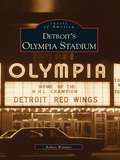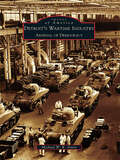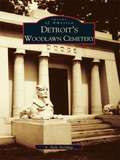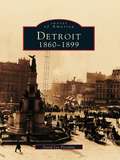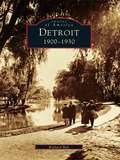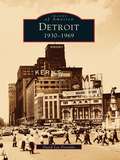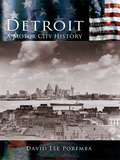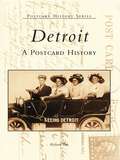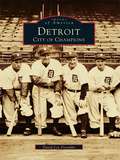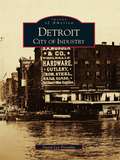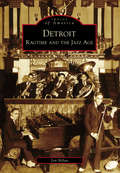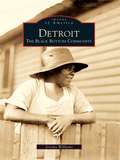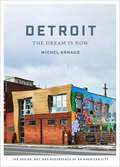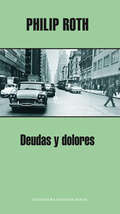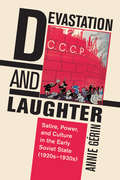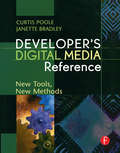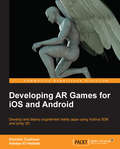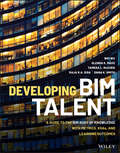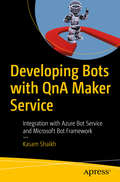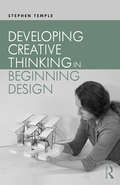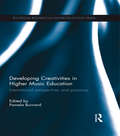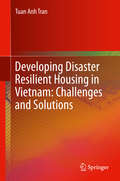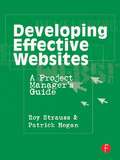- Table View
- List View
Detroit's Olympia Stadium
by Robert WimmerAlso known as the Old Red Barn, Olympia Stadium was the largest rink in the United States when it opened in Detroit on October 22,1927. Robert Wimmer has compiled over 200 historic photographs and detailed captions for this new book, that follows the life of a sporting and entertainment landmark in the Motor City until its demolition in 1986. For over half a century, the Olympia Stadium hosted many of the top shows and stars coming through Detroit. The historic landmark filled its seats for the multitude of sporting events in Michigan, including championship boxing, wrestling, and lacrosse, and was also the home of the Detroit Redwings and the Pistons. Although there are many anonymous people pictured here who contributed to the history of the stadium, readers will recognize the more familiar faces and acts of Elvis Presley, the Beatles, the Roy Rogers Rodeo, Dick the Bruiser, and many others.
Detroit's Wartime Industry: Arsenal of Democracy (Images of America)
by Michael W. DavisJust as Detroit symbolizes the U.S. automobile industry, during World War II it also came to stand for all American industry's conversion from civilian goods to war material. The label "Arsenal of Democracy" was coined by Pres. Franklin D. Roosevelt in a fireside chat radio broadcast on December 29, 1940, nearly a year before the United States formally entered the war. Here is the pictorial story of one Detroiter's unique leadership in the miraculous speed Detroit's mass-production capacity was shifted to output of tanks, trucks, guns, and airplanes to support America's victory and of the struggles of civilians on the home front.
Detroit's Woodlawn Cemetery
by A. Dale NorthupA repository of community memory, exquisite architectural structures, and lasting tributes to the departed, Woodlawn Cemetery serves as a testament to Detroit's multi-faceted history. Considered by many as an outdoor museum of Detroit's architectural, economic, social, and cultural vitality, Woodlawn is the final resting place of the Dodge Brothers, Edsel and Eleanor Ford, Hazen Pingree, and James Couzens, along with countless other historic figures. Through a rare collection of photographs, this book serves as a guided tour along the paths of Woodlawn, from the work of noteworthy architects and sculptors to the legacies of the extraordinary people who have shaped Detroit history.
Detroit: 1860-1899 (Images of America)
by David Lee PorembaIn this rare and unprecedented collection, discover Detroit as it once was, with the people and industries that flourished in this community prior to the twentieth century. With over 230 photographs, Detroit 1860-1899 encompasses a visual history of the city before the birth of the automobile industry. Join Mr. Poremba on a trip down memory lane to the beginnings of the "Motor City." Witness its growth and change, and its lasting contributions to our nation's history. Detroit 1860-1899 will be enjoyed by young and old, resident and visitor alike.
Detroit: 1900-1930
by Richard BakIn this new addition to the Images of America series,Richard Bak takes us on a visual journey through Detroit's golden era, encompassing the first three decades of the twentieth century. It was during this time that the City of Detroit experienced its most rapid physical growth and underwent an unprecedented pace of social and technological change. Detroit: 1900-1930 contains nearly 190 illustrations, including studio portraits, snapshots, postcards, songsheet covers, and period advertisements. Collectively, these images evoke a past that is often too easily forgotten as older Detroiters pass away. As you thumb through the pages of this book, you will encounter such influential people as Henry Ford and other automotive pioneers who helped to "put the world on wheels." Experience daily life as it was lived at the time of the First World War, and discover the major role Detroit played in this historic conflict. This volume highlights the wave ofimmigration that occurred here at the turn of the century, when roughly half of the city's population hailed from other countries. Also featured are various scenes from the "Roaring Twenties," the ill-fated experiment in Prohibition, and the effect of the Great Depression on the city's economy.
Detroit: 1930-1969 (Images of America)
by David Lee PorembaAs the roaring twenties came to an end and a new decade dawned, the United States found itself locked in the grips of the Great Depression. The City of Detroit was no exception as industry laid off workers and bread lines formed across the city. Detroit Mayor Frank Murphy let the country in supporting state and federal welfare programs to help people through the economic crisis. By the middle of the 1930s, Detroit began picking itself up out of the economic mud and was soon flexing its industrial muscle as manufacturing, led by the auto industry, put the Motor City back into shape. As the decade ended and war approached, the city was ready to take its place on the world stage. The country reeled from the shock of the attack on Pearl Harbor and had to shift its industrial might from civilian use to the war effort. Nowhere was that more evident than in Detroit. Its huge manufacturing capabilities, when turned to the making of the implements of war, earned the city a new nickname. The Motor City became to the Arsenal of Democracy and began to evolve once more. The influx of workers from the Deep South to the war industry added yet another facet to the city's society and culture. As the Second World War came to a close and production re-tooled for the return to civilian life, an economic boom swept through Detroit. The city celebrated its 25oth birthday in 1951, prompting an outpouring of funds to build with. Major additions were made to the Art Institute, the Detroit Historical Museum, and the riverfront.
Detroit: A Motor City History
by David Lee PorembaOn July 24, 1701, Antoine de La Mothe Cadillac stood in the heart of the wilderness on a bluff overlooking the Detroit River and claimed this frontier in the name of Louis XIV; thus began the story of Detroit, a city marked by pioneering spirits, industrial acumen, and uncommon durability. Over the course of its 300-year history, Detroit has been sculpted into a city unique in the American experience by its extraordinary mixture of diverse cultures: American Indian, French, British, American colonial, and a variety of immigrant newcomers. Detroit: A Motor City History documents the major events that shaped this once-small French fur-trading outpost across three centuries of conflict and prosperity. Through informative text and a variety of imagery, readers experience firsthand the struggles of the nascent village against raiding Indian tribes and the incessant political and military tug of war between the colonial French and English, and then American interests. Like many other major cities across the United States, Detroit played a pivotal role in establishing the country's economic and industrial power in the nineteenth and twentieth centuries, serving as a center for its well-known civilian and military mass-production resources. This visual history provides insight into Detroit's rapid evolution from a hamlet into a metropolis against a backdrop of important community and national affairs: the decimating fire of 1805, the War of 1812, the Civil War, the Industrial Revolution, the Great Depression, and both world wars.
Detroit: A Postcard History (Postcard History Series)
by Richard BakPostcard photographers traveled the length and breadth of the nation snapping photographs of busy street scenes, documenting local landmarks, and assembling crowds of neighborhood children only too happy to pose for a picture. These images, printed as postcards and sold in general stores across the country, survive as telling reminders of an important era in America's history.
Detroit: City of Champions
by David Lee PorembaProfessional sports have played an important part in the history of the people and the City of Detroit since the turn of the century. Detroit sports teams have given the city a unique identity and provided the means to gain both a sense of community pride and a unity of spirit. At no other time was this more evident than during the decades from the 1920s through the 1950s, when Detroit teams rose consistently to the top of their individual professions. In 1935, the three professional sports teams in Detroit accomplished a remarkable feat by each winning their respective league titles and going on to capture the World Championships of baseball, football, and hockey, earning for the City of Detroit the honored sobriquet of "City of Champions." Here began a close and lasting relationship between Detroit sports teams and their fans.
Detroit: City of Industry
by David Lee PorembaDetroit is known worldwide as the automotive capital of the world. What is not widely known is that, prior to the birth of the automobile, a tremendous diversity of manufactured goods transformed Detroit from a frontier town into a great industrial city. Another vital installment in a series of books about the Dynamic City, Detroit: City of Industry illustrates a slice of the city's history that is largely unknown. Through a collection of remarkable images that are among the oldest in the city, Detroit is revealed as a thriving, bustling manufacturing town that served as the world's leader in a number of important industries. Bessemer steel, iron, steel rails, freight cars, stoves, lumber, drugs, and cigars are just a few of the products that helped the city build the capital that was later needed to prosper during the automobile era. This book examines Detroit's development from the 1860s through the 1890s, and its evolution into a leading industrial center of the Midwest.
Detroit: Ragtime and the Jazz Age
by Jon MilanDetroit has always been at the forefront of American popular music development, and the ragtime years and jazz age are no exception. The city's long history of diversity has served the region well, providing a fertile environment for creating and nurturing some of America's most distinctly indigenous music. With a focus on the people and places that made Detroit a major contributor to America's rich musical heritage, Detroit: Ragtime and the Jazz Age provides a unique photo journal of a period stretching from the Civil War to the diminishing years of the big bands in the early 1940s.
Detroit: The Black Bottom Community (Images of America)
by Jeremy WilliamsBetween 1914 and 1951, Black Bottom's black community emerged out of the need for black migrants to find a place for themselves. Because of the stringent racism and discrimination in housing, blacks migrating from the South seeking employment in Detroit's burgeoning industrial metropolis were forced to live in this former European immigrant community. During World War I through World War II, Black Bottom became a social, cultural, and economic center of struggle and triumph, as well as a testament to the tradition of black self-help and community-building strategies that have been the benchmark of black struggle. Black Bottom also had its troubles and woes. However, it would be these types of challenges confronting Black Bottom residents that would become part of the cohesive element that turned Black Bottom into a strong and viable community.
Detroit: The Dream Is Now
by Michel ArnaudDetroit: The Dream Is Now is a visual essay on the rebuilding and resurgence of the city of Detroit by photographer Michel Arnaud, co-author of Design Brooklyn. In recent years, much of the focus on Detroit has been on the negative stories and images of shuttered, empty buildings—the emblems of Detroit’s financial and physical decline. In contrast, Arnaud aims his lens at the emergent creative enterprises and new developments taking hold in the still-vibrant city. The book explores Detroit’s rich industrial and artistic past while giving voice to the dynamic communities that will make up its future. The first section provides a visual tour of the city’s architecture and neighborhoods, while the remaining chapters focus on the developing design, art, and food scenes through interviews and portraits of the city’s entrepreneurs, artists, and makers. Detroit is the story of an American city in flux, documented in Arnaud’s thought-provoking photographs.
Deudas y dolores
by Philip RothDeudas y dolores es la primera novela larga de Philip Roth. Ambientada en la década de 1950 en Chicago, Nueva York y Iowa City, presenta un brillante retrato de ficción de los Estados Unidos de mediados del siglo XX, caracterizado por limitaciones sociales y éticas y por unas obligaciones morales muy distintas a las de hoy. Recién licenciado del ejército que intervino en en la guerra de Corea, toda todavía bajo el impacto de la reciente muerte de su madre, liberado de viejas ataduras y en ávida búsqueda de otras, Gabe Wallach se siente atraído por Paul Herz, estudiante graduado de literatura, y por Libby, la temperamental y vehemente esposa de Paul. El deseo que siente Gabe de vincularse al ordenado «mundo de sensibilidad» que encuentra en los libros se ve puesto a prueba por la anárquica lucha de los Herz por adaptarse a una vida adulta responsable y más tarde, impulsado por el deseo de vivir seriamente y de actuar con generosidad, Gabe tropieza con una prueba insuperable en la persona de Martha Reganhart. La compleja relación entre Gabe y Martha, y el entusiasmo moral de Gabe por las tribulaciones ajenas, constituyen el núcleo de esta novela trágicamente cómica.
Deutsche Kino-Wochenschau und der wirtschaftliche Aufschwung in West und Ost: Audiovisuelle Gestaltung und Vermittlungsstrategie in Fallanalysen (1950-1965)
by Sigrun LehnertIn der Zeit des wirtschaftlichen Aufschwungs Deutschlands nach dem Zweiten Weltkrieg waren die Wochenschauen im Vorprogramm jeder Kinovorstellung eine bedeutende Informationsquelle. Mit eindrucksvollen Bildern auf einer großen Leinwand – begleitet von gesprochenem Kommentar, Musik und Geräusch – gaben sie Orientierung und prägten die Erinnerung. In zahlreichen dokumentarischen Film- und Fernsehformaten werden bis heute einzelne Bilder oder kurze Sequenzen aus der Kino-Wochenschau als historische Belege, als Illustrationen oder zur Dramatisierung verwendet. Die außergewöhnlichen Prinzipien der Informationsvermittlung kommen dabei jedoch nicht mehr zur Geltung. Um das Publikum zu erreichen, war damals eine Mischung aus informativen Berichten und unterhaltenden Beiträgen unerlässlich. Die in diesem Buch vorgenommenen Fallanalysen spiegeln elementare Themenbereiche der Zeit des wirtschaftlichen Aufschwungs beider deutscher Staaten (1950-1965) wider. Neben den Prinzipien der audiovisuellen Gestaltung wird auch die zentrale Vermittlungsstrategie herausgearbeitet. Transmediale und transnationale Aspekte, die hierbei eine Rolle spielen, weisen die Wochenschau als Teil eines (internationalen) Mediensystems aus.
Deutschsprachige Kinder- und Jugendliteratur im Medienverbund 1900-1945 (Studien zu Kinder- und Jugendliteratur und -medien #3)
by Petra Josting Marlene Antonia Illies Matthias Preis Annemarie WeberMit der Erforschung der deutschsprachigen Kinder- und Jugendliteratur und ihrer Medienverbünde im Zeitraum von 1900 bis 1945 sowie der Erfassung sämtlicher Daten in einem Onlineportal zur Recherche und visuellen Analyse liegt ein innovativer Beitrag zur Geschichtsschreibung der Kinder- und Jugendliteratur vor. Die Einleitung gibt Auskunft über Aufnahmekriterien, zentrale Quellen, theoretische Rahmungen sowie das Spektrum der eruierten Medienverbünde. Teil I versammelt drei Überblicksartikel zu den Medien Hörfunk, Film und Theater für Kinder und Jugendliche sowie einen Beitrag zur Konzeption und Entwicklung des Onlineportals. Im zweiten Teil werden 18 ausgewählte Medienverbünde vorgestellt, sortiert in die Kategorien Pioniere erobern die neuen Medien – Bühnenkinder wandern zum Rundfunk und/oder Film – Märchen im Film und Rundfunk – Klassiker in allen Medien – Schulgeschichten im Theater, Buch und auf der Leinwand – Verbrechen und Skandalöses auf der Leinwand – Politisches erobert Buch und Film.
Devastation and Laughter: Satire, Power, and Culture in the Early Soviet State (1920s–1930s)
by Annie GérinIn Devastation and Laughter, Annie Gérin explores the use of satire in the visual arts, the circus, theatre, and cinema under Lenin and Stalin. Gérin traces the rise and decline of the genre and argues that the use of satire in official Soviet art and propaganda was neither marginal nor un-theorized. The author sheds light on the theoretical texts written in the 1920s and 1930s by Anatoly Lunacharsky, the Soviet Commissar of Enlightenment, and the impact his writings had on satirists. While the Avant-Garde and Socialist Realism were necessarily forward-looking and utopian, satire afforded artists the means to examine critically past and present subjects, themes, and practice. Devastation and Laughter is the first work to bring Soviet theoretical writings on the use of satire to the attention of scholars outside of Russia. By introducing important bodies of work that have largely been overlooked in the fields of art history, film and theatre history, Annie Gérin provides a nuanced and alternative reading of early Soviet art.
Developer's Digital Media Reference: New Tools, New Methods
by Curtis Poole Janette BradleyDesigned for media professionals working across a broad range of formats, Developer's Digital Media Reference is an excellent reference guide for those keeping pace with this dynamic industry. As "convergence" between the World Wide Web, multimedia, and television production communities continues, there is an increased demand for professionals to familiarize themselves with the many new delivery contexts, including hybrid DVD (where digital video content and computer data live on the same disc), interactive TV, and streaming media. Developer's Digital Media Reference covers essential technologies such as SVG (scalable vector graphics), SMIL (Synchronized Multimedia Integration Language, a markup language for creating animations on the web), MPEG-4 (compression standard for streaming audio/video), and Dynamic Web Applications. In addition to serving as a quick-look-up guide, this text is organized to explain today's major media: server-based architectures, disc-based architectures, distribution architectures, and merging/shared architectures. Each topic is discussed in terms of the technological background-evolution, current tools, and production tips and techniques.
Developing AR Games for iOS and Android
by Dominic Cushnan Hassan El HabbakA practical and fast-paced guide that gives you all the information you need to start developing augmented reality games for iOS and Android.This book is great for people who are either new to Vuforia and/or new to Unity. It is a great introductory guide for anyone with a very basic knowledge of xCode and iOS as well as a very basic knowledge of deploying to Android to start developing 3D-powered augmented reality apps.
Developing BIM Talent: A Guide to the BIM Body of Knowledge with Metrics, KSAs, and Learning Outcomes
by Wei Wu Dana K. Smith Glenda K. Mayo Tamera L. McCuen Raja R. IssaA systematic Building Information Modeling (BIM) framework features cutting-edge use cases and competencies for students and professionals pursuing BIM careers. Developing BIM Talent: A Guide to the BIM Body of Knowledge with Metrics, KSAs, and Learning Outcomes leads readers through the process of implementing a state-of-the-art BIM training and education program. Authored by a team of celebrated and highly qualified scholars and practitioners, this exciting new BIM education and workforce development guide offers a roadmap that navigates readers through the comprehensive BIM metrics and KSAs detailed in the BIM Body of Knowledge sponsored by the Academic Interoperability Coalition (AiC). Developing BIM Talent offers: A solid foundation and guidelines for educators and practitioners for starting or enhancing a BIM curriculum or training program Templates, expert interviews, and case studies that provide in-depth knowledge and lessons learned that can facilitate process changes and strategic action plans Strategies for standardizing emerging BIM job tasks, descriptions, and methods for benchmarking performance This guide to contemporary and comprehensive metrics of BIM competency is an essential resource for corporate trainers and instructors teaching BIM, human resources professionals charged with recruiting BIM talent, as well as leadership interested in credentialing and BIM certification programs.
Developing Bots with QnA Maker Service: Integration with Azure Bot Service and Microsoft Bot Framework
by Kasam ShaikhLearn to develop bots with zero coding knowledge using the Azure Cognitive QnA Maker service, a GUI cognitive service from Microsoft. This book shows you how to integrate QnA Maker with the Azure Bot Service and Microsoft Bot Framework, along with how to integrate your bot with social channels such as Web Chat, and Telegram. You will learn what QnA Maker is, why you should use this service in enterprise settings, when you should use this service, and how you should use the service. Developing Bots with QnA Maker Service takes you through the QnA Maker FAQ knowledge base with Azure Bot Service, where you will discover how to get started with a web app bot using the Azure portal. This section culminates in deploying your bot on Azure Web App, making your bot live. Next, you will learn QnA Maker with the .NET Framework and Visual Studio 2017 along with ways to manage QnA Maker service post deployment. Finally, you will learn how to add media content including videos and images to the QnA Maker knowledge base. After reading this book you will be able to develop bots using the latest .NET Framework, Visual Studio 2017, and the Microsoft online code editor. What You Will LearnCustomize QnA Maker default components, using the Azure portalWork with Microsoft Bot FrameworkDevelop and integrate FAQ bots with Azure Bot ServiceManage FAQ bots using the .NET Framework and the Azure portalWho This Book Is ForDevelopers/architects with an interest in building chatbots.
Developing Creative Thinking in Beginning Design
by Stephen TempleLearning to think and act creatively is a requisite fundamental aspect of design education for architectural and interior design as well as industrial and graphic design. Development of creative capacities must be encountered early in design education for beginning students to become self-actualized as skillful designers. With chapters written by beginning design instructors, Developing Creative Thinking in Beginning Design addresses issues that contribute to deficiencies in teaching creativity in contemporary beginning design programs. Where traditional pedagogies displace creative thinking by placing conceptual abstractions above direct experiential engagement, the approaches presented in this book set forth alternative pedagogies that mitigate student fears and misconceptions to reveal the potency of authentic encounters for initiating creative transformational development. These chapters challenge design pedagogy to address such issues as the spatial body, phenomenological thinking, making as process, direct material engagement and its temporal challenges, creative decision making and the wickedness of design, and the openness of the creative design problem. In doing so, this book sets out to give greater depth to first design experiences and more effectively enable the breadth and depth of the teacher–student relationship as a means of helping your students develop the capacity for long-term self-transformation.
Developing Creativities in Higher Music Education: International Perspectives and Practices (Routledge Research in Higher Education)
by Pamela BurnardThis is the first book to critically address the issue of how we can enhance and develop creativities in higher music education. It features new international, richly diverse perspectives on the nature and practice of creativities in different cultural and institutional contexts, in varying roles and in response to diverse professional pressures and expectations of artistic and educational achievement. This compelling and provocative book combines powerful social and educational commentaries and examples drawn from international sources based on original practices and experience of a diversity of creativities. The authors provide an important contribution by drawing attention to what is at the heart of all music and how we can understand and foster these multiple creativities at an individual and institutional level. It features new analyses of the question of creativities in higher music education, and offers illustrative and innovative examples of adaptive learning environments for teaching and learning creatively, considering the broader issue of the role of creativities in relation to educational policy in the context of increasingly interventionist governments and rapidly paced educational change. Topics covered include: -the conceptual tools for people to think about and debate multiple creativities -the role of creativities in higher music education-how musicians can develop multiple creativities in new ways -new approaches to teaching and learning for multiple creativities -what constitute leadership creativities in conservatoires and music departments-creativities at the interface of institutional learning cultures-assessing the multiple creativities of music. Developing Creativities in Higher Music Education offers a multi-disciplinary research and practice focus, which will be essential reading for anyone involved in higher education and industry sectors. The book will appeal to academics and practitioners in music, researchers, instrumental and vocal teachers, curriculum and policy developers and institutional managers who want to enrich the higher education experiences of their students and enable them to develop more of their creative potential. It is also ideal reading for undergraduate and postgraduate students of music education who are looking for an authoritative selection of writings that define the fields of musical creativities in one comprehensive volume.
Developing Disaster Resilient Housing in Vietnam: Challenges and Solutions
by Tuan Anh TranThis book provides a comprehensive understanding on disaster resilient housing within the Vietnam context particularly and the developing world generally. The book has identified the root causes of housing vulnerability, restrictions to safe housing development, concepts of disaster resilient housing, key issues/factors implementers and building designers need to consider, and ways of achieving resilient housing outcomes in actual design projects. The design and development of disaster resilient housing has been framed into three main themes: (i) community consultation, (ii) the role of built-environment professionals and (iii) design responses for resilience. To achieve these themes, there is a variety of contextual and intervening conditions that need to be addressed and met to provide an enabling environment for promoting disaster resilient housing. These three themes are among the most arguable issues in recent debates and discussions, academically and practically, regarding disaster risk reduction and safe housing development. In addition, this book also provides the evidence-based design framework for disaster resilient housing upon which design ideas and solutions for safe and resilient housing can be generated and shaped.
Developing Effective Websites: A Project Manager's Guide
by Patrick Hogan Roy StraussIs your website project out of control?Every website project needs a manager. Developing Effective Websites describes Internet technologies in plain language and helps you see beyond your expertise to the big picture. It does this by drawing on established software project and management principles. Like any project, effective management of website development starts by understanding and balancing the constraints of time, resources, and tasks. You can deliver your project on time and on budget, by following a process that includes:· Analyzing the requirements of users and your market· Developing a workplan for the site and breaking it down to tasks· Scheduling with Gantt and PERT charts and measuring slippage for more accurate revisions· Estimating cost by the budget-first or design-first methods · Using the team development process and covering all the necessary roles· Aligning contractor and client interests to create a win-win relationship· Following an iterative development process for designing, prototyping, and building out· Applying software testing principles to website development· Making hosting decisions and planning for maintenance
